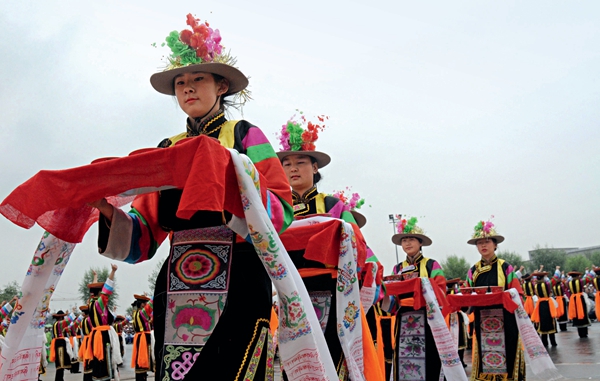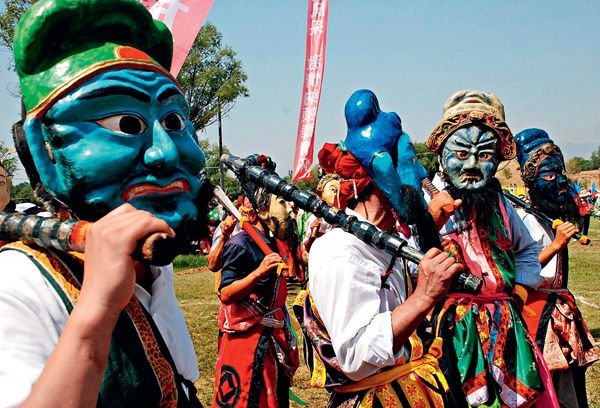Festival to Celebrate a Bumper Crop
China Today,September 14, 2017 Adjust font size:
Celebrating the Harvest
Nadun is an appropriation of the Mongolian word Nadam, meaning to have fun or play. It is a thanksgiving for the Tu people, which happens after the autumn harvest, and is full of entertainment and folk dancing. The date of the festival varies from place to place, most starting around harvest time. The festival on the plains happens earlier than that of the mountainous areas, roughly from mid-July to mid-September on the lunar calendar. It began, in its original form, as a ceremony to worship the god Er-Lang and pray to the local patron saint for good weather and a bumper grain harvest. Now it has evolved into a popular annual folk festival.

Tu maidens offering highland barley wine to visitors.
According to local folk tales, once upon a time, Qinghai suffered numerous disastrous harvests; not a single grain was reaped for many years. Local people asked the priests to pray for the grace of the gods, but nothing came of it. Later, a wooden statue of the god Er-Lang was brought from Sichuan, which was believed to be the image of Li Erlang, son of Li Bing, the father and son team who had led the construction of the famous irrigation system Dujiangyan. The Tu people built temples in their villages and devotedly worshipped the god, asking him to bless their harvest in autumn. And that year there was good weather for the crops; the harvest had a good yield. The jubilant villagers did not know how to express their immeasurable joy. They put the statues into a large sedan chair carried by eight people, and paraded around the nearby villages to show their gratitude. This was a tale about the beginning of the Nadun Festival. Actually, its history can be traced back even further. The festival first became established when the Tu’s ancestors started to change from a nomadic into a more agrarian lifestyle, and as time went on, the traditional festival became central to the celebration of harvest.
There are group activities that involve each village. Sometimes they are held by one village, sometimes jointly conducted by two villages, with one as the host and the other as the guest. In the morning, families from the host village bring steamed cake, cigarettes, and wine to the threshing area, and offer them as tributes. As the ceremony begins, performers from the host village wait outside the village to welcome performers from the guest village. The two groups form a procession and walk to the threshing floor, carrying multicolored flags to the accompaniment of gongs and drums. At the most exciting moment of the performance, dozens of drums are played in time and dancers jump and shout loudly, showcasing their majestic athleticism and strength.
The large-scale dance performance usually consists of 50 people of all ages. At the front are older villagers, wearing long gowns and holding fans. These people are usually the organizers of the festival and guardians of the Nadun dance, which they have passed down to the younger generations. Although over the age of 60, they are still agile and graceful dancers. Following them are the young people, holding colored flags, and children holding willow twigs. Swinging their arms, they dance around the field. Accompanied by the rhythmic beating of drums and gongs, the dancers jump and swing in time with each other, looking quite graceful and energetic. Meanwhile, the hosts toast the performers with big bowls of liquor to add to the fun. People are enchanted by the dancing, creating a jubilant and joyous atmosphere. And so the Nadun Festival begins.

The performance of the exorcism dance is an important part of the Nadun Festival.
The busy festival naturally provides a good opportunity to visit friends and relatives. Early in the morning, all people, regardless of age and sex, dress up and parade along the country roads in formidable array. Throughout the festival, guests and friends crowd each other’s houses, and all are radiant with joy. They share their best greetings and enjoy the happy festival time together. Hosts treat guests with fine wine and steamed cakes. Travelers who enter the home of a hospitable Tu family will also be received with cordial hospitality. If there are any acrimonious relationships between two people or two villages, they will visit each other to apologize, toasting each other with a big bowl of wine and the disagreement will be resolved as the two are reconciled.